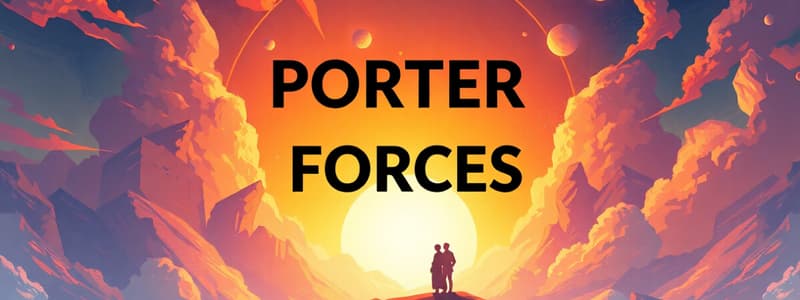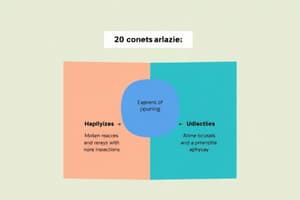Podcast
Questions and Answers
A company aiming to build significant customer loyalty and create an ecosystem around its products would MOST likely employ which product strategy?
A company aiming to build significant customer loyalty and create an ecosystem around its products would MOST likely employ which product strategy?
- Focusing primarily on internal operational efficiency improvements.
- Prioritizing individual product features over the overall user experience.
- Creating a system that makes switching to competitors costly or inconvenient. (correct)
- Competing based solely on offering the lowest price point in the market.
In value chain analysis, which of the following activities is considered a primary activity?
In value chain analysis, which of the following activities is considered a primary activity?
- Technology Development
- Operations (correct)
- Procurement
- Human Resources Management
A company is experiencing declining profits despite stable sales volume. Which framework would be the MOST suitable FIRST step for identifying the core issues?
A company is experiencing declining profits despite stable sales volume. Which framework would be the MOST suitable FIRST step for identifying the core issues?
- Root Cause Analysis
- Supply & Demand Analysis
- Profitability Framework (correct)
- The 4Ps of Marketing
When a business decides to expand into a completely new geographical market, which overarching strategic question is it addressing?
When a business decides to expand into a completely new geographical market, which overarching strategic question is it addressing?
A manufacturing company wants to reduce waste and improve the speed of its production line. Which framework would be MOST helpful in achieving this goal?
A manufacturing company wants to reduce waste and improve the speed of its production line. Which framework would be MOST helpful in achieving this goal?
A software company is facing a new competitor offering a similar product at a significantly lower price. Which of the following is NOT a potential strategic response, according to the frameworks?
A software company is facing a new competitor offering a similar product at a significantly lower price. Which of the following is NOT a potential strategic response, according to the frameworks?
A company is planning to introduce a new line of eco-friendly cleaning products. Which framework would assist them in defining their target audience and crafting their initial marketing message?
A company is planning to introduce a new line of eco-friendly cleaning products. Which framework would assist them in defining their target audience and crafting their initial marketing message?
A small bakery wants to determine the optimal price for its new artisan bread to maximize profit. Which framework should guide this decision?
A small bakery wants to determine the optimal price for its new artisan bread to maximize profit. Which framework should guide this decision?
Which of the following scenarios best illustrates the 'Threat of New Entrants' force within Porter's Five Forces framework?
Which of the following scenarios best illustrates the 'Threat of New Entrants' force within Porter's Five Forces framework?
A company discovers that its suppliers are increasing prices due to a limited number of available providers. According to Porter's Five Forces, this situation exemplifies:
A company discovers that its suppliers are increasing prices due to a limited number of available providers. According to Porter's Five Forces, this situation exemplifies:
Which action would most effectively reduce the bargaining power of buyers in a given market?
Which action would most effectively reduce the bargaining power of buyers in a given market?
A movie theater faces declining attendance as more people choose to stream movies at home. This scenario is an example of which of Porter's Five Forces?
A movie theater faces declining attendance as more people choose to stream movies at home. This scenario is an example of which of Porter's Five Forces?
A small startup develops a revolutionary new technology but struggles to protect it from being copied by larger competitors. According to the VRIO framework within the Resource-Based View, which criterion is the startup failing to meet?
A small startup develops a revolutionary new technology but struggles to protect it from being copied by larger competitors. According to the VRIO framework within the Resource-Based View, which criterion is the startup failing to meet?
A company possesses a valuable and rare resource that is difficult for competitors to imitate. However, they are unable to effectively leverage this resource due to poor management and inefficient processes. According to the VRIO framework, which criterion is lacking?
A company possesses a valuable and rare resource that is difficult for competitors to imitate. However, they are unable to effectively leverage this resource due to poor management and inefficient processes. According to the VRIO framework, which criterion is lacking?
Which of the following best describes a business leveraging intangible resources for competitive advantage, according to the Resource-Based View?
Which of the following best describes a business leveraging intangible resources for competitive advantage, according to the Resource-Based View?
According to the Resource-Based View (RBV), what is the MOST important factor for a resource to provide a sustained competitive advantage?
According to the Resource-Based View (RBV), what is the MOST important factor for a resource to provide a sustained competitive advantage?
Flashcards
Best Product Strategy
Best Product Strategy
Compete on quality, price, and efficiency to be the best.
Total Customer Solutions
Total Customer Solutions
Build strong, lasting relationships with customers.
System Lock-In
System Lock-In
Create an ecosystem that makes switching costly.
Value Chain Analysis
Value Chain Analysis
Signup and view all the flashcards
Supply & Demand Analysis
Supply & Demand Analysis
Signup and view all the flashcards
The 3Cs Model
The 3Cs Model
Signup and view all the flashcards
The 4Ps of Marketing
The 4Ps of Marketing
Signup and view all the flashcards
How to Improve Profits
How to Improve Profits
Signup and view all the flashcards
Competitive & Business Strategy Frameworks
Competitive & Business Strategy Frameworks
Signup and view all the flashcards
Porter's Five Forces
Porter's Five Forces
Signup and view all the flashcards
Threat of New Entrants
Threat of New Entrants
Signup and view all the flashcards
Bargaining Power of Suppliers
Bargaining Power of Suppliers
Signup and view all the flashcards
Bargaining Power of Buyers
Bargaining Power of Buyers
Signup and view all the flashcards
Threat of Substitutes
Threat of Substitutes
Signup and view all the flashcards
Industry Rivalry
Industry Rivalry
Signup and view all the flashcards
Resource-Based View (RBV)
Resource-Based View (RBV)
Signup and view all the flashcards
Study Notes
Competitive & Business Strategy Frameworks
- These frameworks support businesses in analyzing competition and developing strategies.
- These strategies help businesses gain a competitive edge.
Porter’s Five Forces (Industry Competitiveness)
- This framework helps in understanding industry structure and profitability.
- Aids in assessing market attractiveness prior to market entry.
- The threat of new entrants is lower where barriers to entry are high.
- High barriers to entry include: high capital requirements, strong brand loyalty, and economies of scale.
- Example: The airline industry requires massive investment, deterring new entrants.
- The bargaining power of suppliers is high if only a few suppliers control the market.
- Powerful suppliers can increase prices or reduce quality.
- Example: Boeing & Airbus have significant power over airlines because they dominate aircraft manufacturing.
- The bargaining power of buyers is high if customers have many alternatives.
- Powerful customers can demand lower prices or better service.
- Example: Supermarkets negotiate bulk discounts from suppliers due to their buying power.
- The threat of substitutes arises from alternative products or services that can replace existing ones.
- Example: Streaming services are replacing cable TV.
- Intense industry rivalry can lead to price wars and reduced profitability.
- Example: The fast-food industry experiences intense competition.
- Use this framework when entering a new market or evaluating competition.
- This framework helps a company decide whether to expand, actively compete, or exit an industry.
Resource-Based View (RBV) (Internal Competitive Advantage)
- This framework focuses on a firm’s unique resources and capabilities as sources of lasting competitive advantage.
- RBV examines what the company possesses that competitors cannot easily replicate.
- Tangible resources are physical assets such as factories, real estate, and inventory.
- Intangible resources include brand reputation, patents, proprietary technology, and company culture.
- Organizational capabilities include an efficient supply chain, effective R&D teams, and excellent marketing.
- The VRIO model includes the competitive advantage criteria: Valuable, Rare, Inimitable, and Organized.
- Valuable: Resources that add value to the company.
- Rare: Resources that are unique.
- Inimitable: Resources that are difficult for competitors to copy.
- Organized: The company can effectively utilize its resources.
- Example: Coca-Cola’s brand value is an intangible asset that is nearly impossible to replicate.
- Example: Google’s algorithm is rare, valuable, and difficult to imitate.
- This framework is best utilized when evaluating internal strengths and for long-term strategic planning.
The Delta Model (Customer-Centric Strategy)
- This model broadens the competitive focus to include customer relationships and ecosystem creation.
- The Best Product strategy focuses on competing based on quality, price, and efficiency.
- Example: Apple
- A Total Customer Solutions strategy aims to build strong, lasting customer relationships.
- Example: IBM’s consulting model
- System Lock-In involves creating an ecosystem that makes switching costly for customers.
- Example: Microsoft Office Suite
- Apple’s ecosystem locks users into the Apple brand.
- This framework is most effective when customer loyalty and ecosystem-building are high priorities.
Value Chain Analysis (Identifying Operational Strengths)
- This analysis identifies where a business adds value and where it can reduce costs.
- Primary activities include: inbound logistics, operations, outbound logistics, marketing & sales, and service.
- Inbound logistics involves managing raw materials.
- Operations involves transforming raw materials into finished products.
- Outbound logistics involves delivering finished products.
- Marketing & Sales efforts are focused on driving customer demand.
- Service encompasses after-sales support.
- Support activities include: procurement, HR management, technology development, and firm infrastructure.
- Amazon's warehouse and logistics operations provide a competitive advantage.
- The advantage comes from reducing costs and speeding up delivery.
- This analysis is useful for cost-cutting and efficiency improvements.
Academic & Business Market Frameworks
- These frameworks are applicable to both academic and business environments.
Supply & Demand Analysis (Market Pricing & Profit Forecasting)
- Supply and demand analysis determines optimal pricing and production levels.
- Appliation: Used in pricing strategy and forecasting profitability.
The 3Cs Model (Company, Competitors, Customers)
- The 3Cs define the major factors influencing business success.
- Application: Used in marketing and strategic positioning.
The 4Ps of Marketing (Product, Price, Place, Promotion)
- The 4Ps are used to develop marketing and product launch strategies.
Logical & Decision-Making Frameworks
Profitability Framework (Revenue vs. Cost Analysis)
- Used to analyze and fix profitability issues.
Root Cause Analysis (Problem Identification)
- Used in troubleshooting and process improvements.
Process Mapping (Operational Optimization)
- Helps identify bottlenecks and inefficiencies.
Case Interview & Problem-Solving Frameworks
How to Improve Profits
- Increase revenue or reduce costs.
How to Grow a Business
- Expand in current markets or enter new markets.
How to Cut Costs
- Identify elimination, efficiency, and negotiation opportunities.
How to Launch a Product
- Focus on target market, pricing, and promotion strategy.
How to Optimize a Process
- Reduce inefficiencies and improve workflow speed.
How to Respond to Competitive Threats
- Mitigate, replicate, or collaborate with the competitor.
Studying That Suits You
Use AI to generate personalized quizzes and flashcards to suit your learning preferences.




